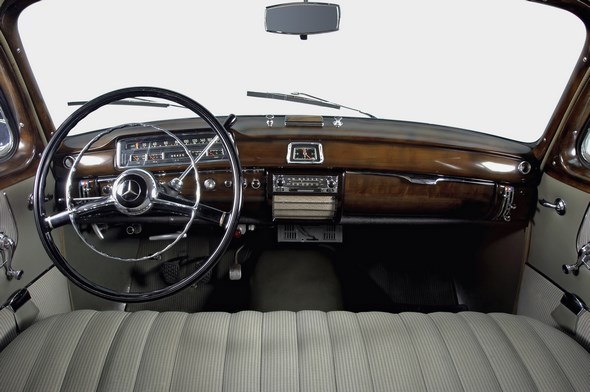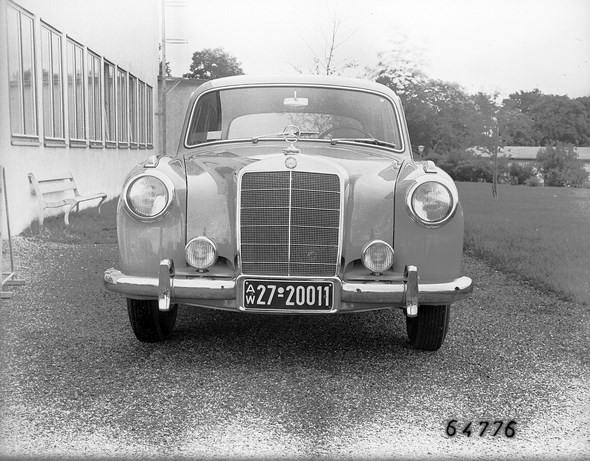Mercedes W180, W105, W128 Ponton 1954 – 1959


In March 1954, a new 220 model with a modern integral concept was presented. It was based on the 180 model, which had been produced for six months by then.

The six-cylinder model, internally code named 220 a or W 180, had an integral ponton-type body, which was firmly welded to the bottom of the framework.
Stylistically, too, there was a close relationship to the 180 model; this was emphasized by the fact that for a layman it was very hard to tell, which was which.

The 220 a, however, had a wheelbase, which had been extended by 170 mm, resulting in an extra 70 mm for leg room in the rear of the cabin.

The remaining 100 mm were used for an extended front of the car, which had become necessary in order to accommodate the six-cylinder engine.
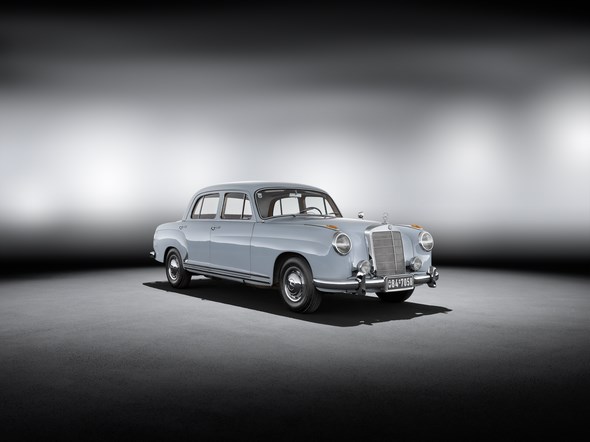
The bonnet came down almost to the bumoers on both sides of the radiator grill and the fresh air inlet ducts were situated immediately behind the standard fog lamps.

In contrast to the smaller brother of the model, the front indicators were now encapsulated in elongated chrome housings, which were mounted at the top front of the fenders.

The front axle suspension as well as the sub-frame concept had been derived from the 180 model; the rear axle suspension was a completely new construction.
For the first time, the single joint cross shaft axle with low pivot, which had been developed for the formula racing car W 196, was used in a serially produced passenger car by Mercedes-Benz.

Extended jointed cross shafts ensured smaller track and camber changes and hence a better driving performance.

The six-cylinder engine of the 220 a was carried over from its predecessor model of series 187, however, it had been modified in some aspects: higher compression, the incorporation of a sharper cam shaft and a bigger carburettor delivered an engine power of 85 hp.
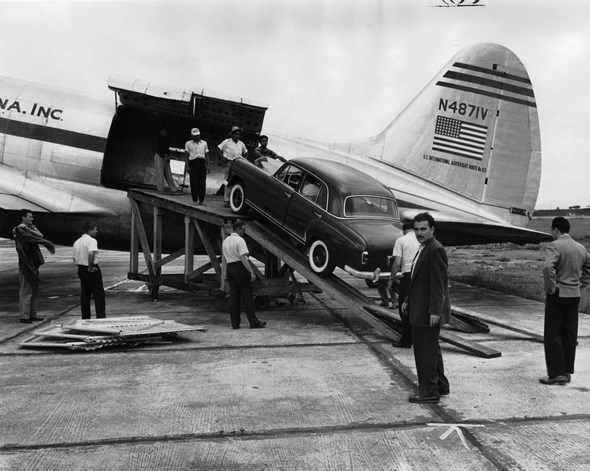
There was a marked improvement in the brakes. The 220 a received ribbed brake drums with “turbo-cooling” at all four wheels, ventilation ducts in the wheel rims and decorative wheel boss caps ensured a sufficient supply of cool air.

From September 1955 the cars were serially fitted with servo units for brakes.

In March 1956, two years following the presentation of the 220 a, the 219 and 220 S models, the successors to the first six-cylinder model with ponton-type body, were unveiled to the public.

The direct successor was the Type 220 S, as can be seen from the internal code name W 180 II. It was almost completely based on its predecessor model, engine power, however, had been increased to 100 hp due to the incorporation of two register carburettors.

On the sub-frame the engine was not only supported at the front, but there were two supports at the back as well. The only distinguishing feature of the exterior of the 220 S model was a single additional trim: the bead on the front fenders and doors has a slender chrome strip on each side.
The second six-cylinder model, which was presented together with the 220 S had the rather unusual and non-prestigious designation 219. This model, which was internally code named W 105, had been constructed by combining the 190 and 220 a types.

As a more affordable six-cylinder model with less generous equipment, it was intended to attract new customers. The engine had been carried over unchanged from the 220 a model, the chassis, the body starting with the A-pillar and the equipment, were taken from the 190 model, however.

The six-cylinder engine necessitated a longer car front, which again corresponded to the 220 a. Accordingly, wheelbase and total length of the 219 were shorter compared to the 220 S, but bigger compared to the 190.

True to the motto “even more value for the same money” almost all passenger car models were presented in August 1957, some with more, some with less significant changes.

Both six-cylinder “ponton” models now had a more powerful engine; the boost in power – 5 hp in the 219 and 6 hp in the 220 S – had been achieved by increasing compression up to 8.7.

Moreover, the interior and the front bumper were also modified; there was a new number plate panel and additional holding devices at the sides.
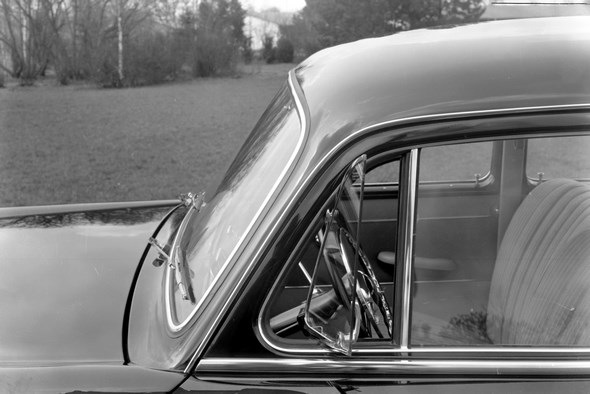
The 220 S also received such additional holding devices at its rear bumper and the front bumpers were fitted with bigger guards, the same as those that had been used in the coupés and convertibles.
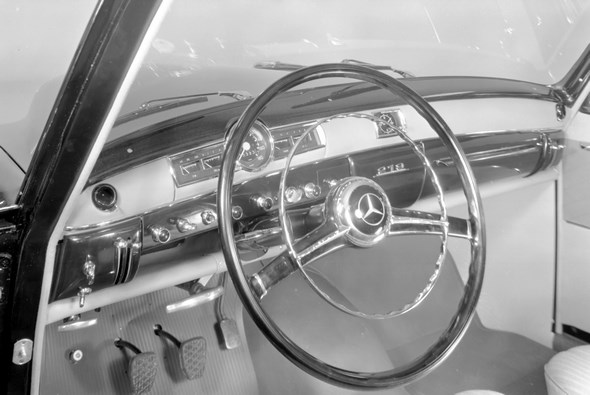
Furthermore, as with the four-cylinder models, the number plate illumination was transferred to the rear bumper guards, so that the new broader number plates, which had been introduced just then, could be mounted easily.
The most remarkable new feature, however, was the introduction of a hydraulic-automatic clutch named “Hydrak”, which was available with both models as an option.

“Hydrak” combined a hydraulic clutch to start the car, a conventional single-disk dry clutch to engage and disengage the clutch during gear change and a freewheel to bypass the hydraulic clutch.

The Type 220 SE, a new six-cylinder model, was presented to the public in September 1958 and came on the market two months later. This model, with the internal designation W 128, was largely identical to the 220 S except for having petrol injection.

This was done by intermittent inlet manifold injection (like the 300 d) and meant that the 2.2-liter engine now produced 115 hp. However, this stronger engine giving better performance with lower fuel consumption had its price: DM 1,900 more than the carburettor version.

The “Hydrak” automatic clutch was available as an option costing DM 450. The high price and short production run (ten months) of this model meant that only 1,974 of the 220 SE were built.
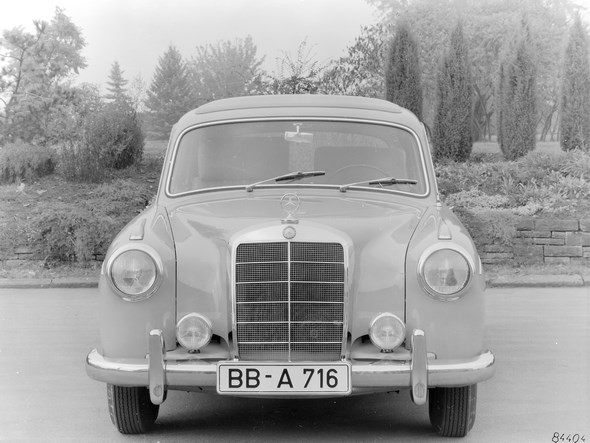
In August 1959 three completely new six-cylinder models of the 111 series were presented as successors to the 219, 220 S and 220 SE. A total of 111,035 six-cylinder saloons with the “ponton” body were produced in five and a half years.

Technically speaking, all Mercedes saloons built since then have had a “ponton”-type body. But the expression “ponton Mercedes” is only used for the original model generation.


